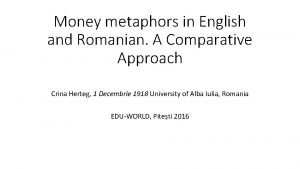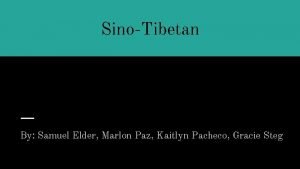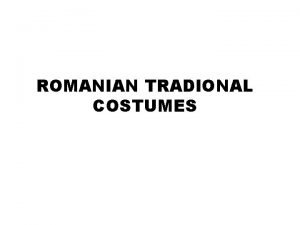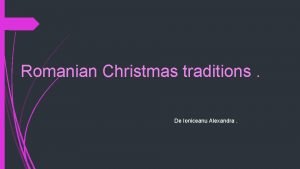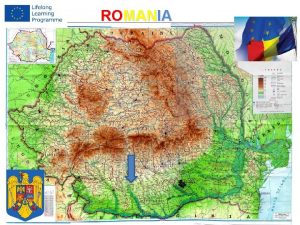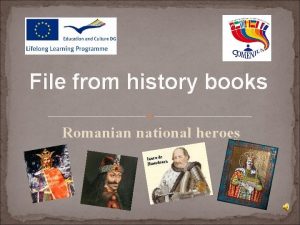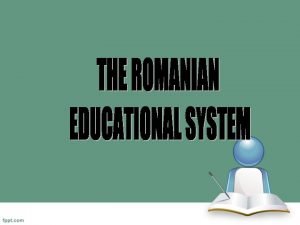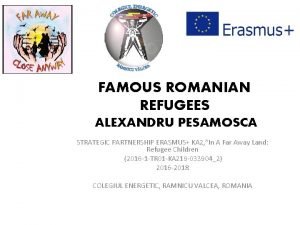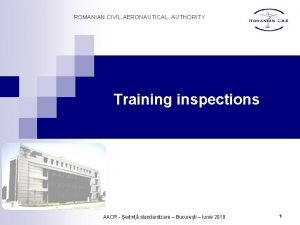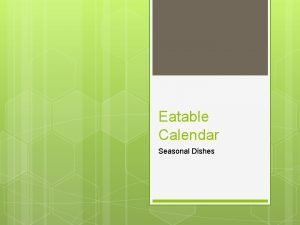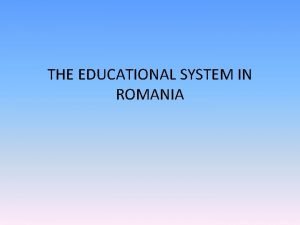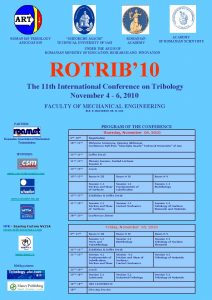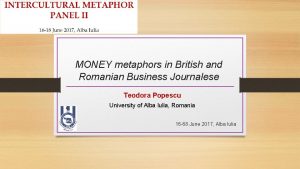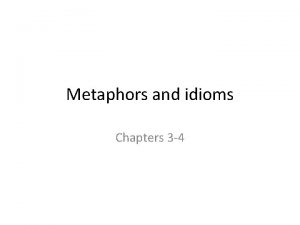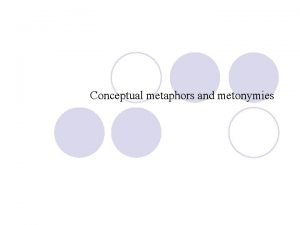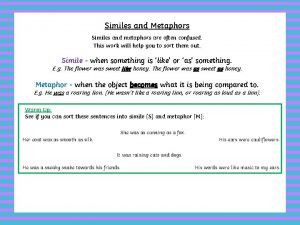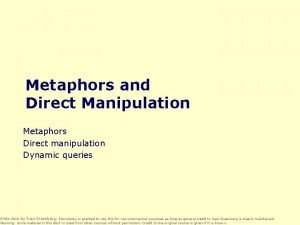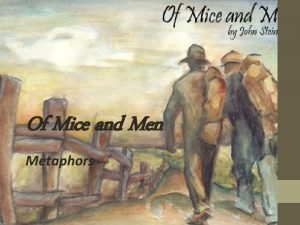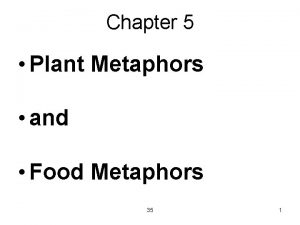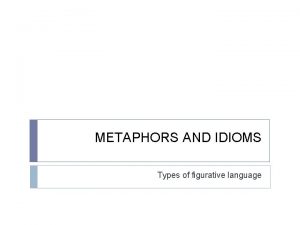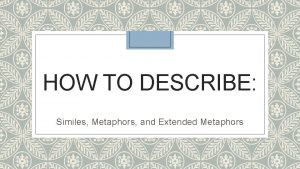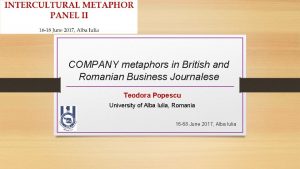Money metaphors in English and Romanian A Comparative














- Slides: 14

Money metaphors in English and Romanian. A Comparative Approach Crina Herteg, 1 Decembrie 1918 University of Alba Iulia, Romania EDU-WORLD, Pitești 2016

1. Introduction The study of metaphors is approached from two perspectives: 1. the traditional view and 2. the cognitive linguistic one The difference between these two perspectives lies in the fact that in the traditional view one word is used instead of another, while in cognitive linguistic view one conceptual domain is used instead of another. In traditional view metaphors are seen as linguistic devices used with the purpose of adorning language. (Kövecses, 2010 ).

2. Literature review Money metaphors have aroused linguists`interest. A comprehensive study of money approached from a diachronic perspective was conducted by Tejada Caller and Guerra (2012 ), it analyses the way money was perceived in classical Greek period 8 th century BC- 6 th century BC. Mouton (2012) also draws on the historical perspective in the study of money metaphors. In the sub-chapter Medieval conceptions of money, the author identifies a series of mappings money and blood in order to show specific economic organs fit into the social body. In his opinion metaphors underlying economic reasoning should be seen as flexible and dynamic processes rather than fixed static systems. Mentioned in References acc to APA

Literature review In her study Towards a better understanding of metaphorical networks in the language of economics: The importance of theory-constitutive metaphors, Resche (2012) dwells on economic and business metaphors. She believes that liquid metaphors are fully exploited when dealing with money. Resche (2012) identifies and analyses the metaphorical networks of the European monetary union before the Euro was born as a marriage, a journey, a club, a construction, religion, a guest, transport, a building. All these metaphorical branches share a common denominator: personification.

3. Research methodology Conceptual metaphors can be explored either by resorting to the lexical approach, advocated by Zoltán Kövecses or by relying on corpus. The methodology we resort to is corpus-based, as we start from the assumption that nowadays almost every attempt to study business metaphors is approached from a corpus perspective. Corpora represent efficient tools in discovering and revealinguistic metaphors, they can facilitate both synchronic and diachronic study of metaphors.

Research methodology Arguments for resorting to corpora include: they enable researchers to conduct quantitative analysis of conceptual metaphors, they draw on the frequency of conceptual metaphors within a type of text or discourse, they open new avenues in the study of conceptual metaphors.

Research methodology For conducting a corpus-based analysis the researcher has to compile a corpus, establish the concordancing program to be used, insert headwords in the concordancing programs, identify, interpret and analyze the findings. The population of texts comprising the corpus depends on the purpose of the analysis. This method is very efficient in analysing long texts, it also has the advantage that larger categories of data can be processed analysed.

Research methodology We resorted to the following methods of extracting conceptual metaphors from the corpus: • 1. Manual annotation using the MIP method; • 2. Automated annotation using the corpus-based approach. Automatic annotation was achieved in two ways: a. searching for target domain; b. searching for source domain.

Findings and results The corpus-based approach enables us to draw on the frequency of headwords which may point to the existence of conceptual metaphors. In the English corpus we identified 400 hits of money, however not all the uses of money are connected with conceptual metaphors. The general idea pervading the texts comprising both corpora is that money is an important aspect of contemporary economy, it is the engine that drives a country`s economy. Money is seen as a valuable possession which must be well-managed and taken care of, the owner must avoid putting money at risk.

Findings and results • Categories identified: 1. Banks are containers for money 2. Money is a liquid 3. Business is war 4. Money is wealth/ Cash is wealth 5. Economy is an engine 6. Time is money 7. More is up

• 8. Less is down • 9. Healthy economy is a healthy organism • 10. Economic vitality is the vitality of an organism

5. Conclusions • The manual and automatic annotation of the corpus leads us to the conclusion that a manual processing of the text is more accurate, more comprehensive and yields more results in comparison with the corpusbased one. It also enables the identification of a higher number of conceptual metaphors. Due to the length of the corpora we had to resort to both types of annotation. • In terms of frequencty the English occurrences of money and its semantic field outnumber the ones in the Romanian corpus, on the other hand the use of money in the English corpus highlights a more positive overtone, while in the Romanian corpus negative connotations of money occur more often. The second headword we searched for cash and its Romanian equivalent yields more hits in the English corpus in comparison with the Romanian one.

References • Cameron, L. , & Low, G. (Eds. ). (1999). Researching and applying metaphors. Cambridge: Cambridge University Press. • Charteris-Black, J. (2004). Corpus approaches to critical metaphor analysis. Basingstoke: Palgrave. Mac. Millan. • Deignan, A. (2008). Corpus linguistics and metaphor. In R. W. Gibbs (Ed. ), The Cambridge handbook of metaphor and thought (pp. 280 -294). Cambridge: Cambridge University Press. • Fuertes-Olivera, P. A. , & Velasco-Sacristan, M. (2012). Translation metaphor in business/ economics dictionary articles: what theory says and what the lexicographers should do. In H. Herrera-Soler & M. White (Eds. ), Metaphors and mills. Figurative language in business and economics (pp. 155 -173). Berlin: De Gruyter Mouton. • Gibbs, W. R. (2008). The Cambridge handbook of metaphor and thought. Cambridge: Cambridge University Press. • Goatly, A. (1998). The language of metaphors. London and New York: Routledge.

References • Herrera-Soler, H. , & White, M. (Eds. ). (2012). Metaphors and mills. Figurative language in business and economics. Berlin: De Gruyter Mouton. • Herteg, C. (2015, October). Money and money-related metaphors in business English. Paper presented at the International Conference 5 th World Conference on Learning, Teaching and Educational Leadership, WCLTA 2015, Paris. Retrieved from www. wclta. org. • Herteg, C. , Popescu, T. , & Iordachescu, G-D. (2015, November). Economic metaphors in business English. Paper presented at the International Conference 3 rd Global Conference on Linguistics and Foreign Language Teaching, LINELT 2015, Istanbul. Retrieved from www. linelt. org. • Herteg, C. (2015, in print). Corpus-based approach to money metaphors in business English. In T. Popescu & G. -D. Iordachescu (Eds. ), Universal and variants of English and Romanian business metaphors. A corpus-based conceptual mapping of contemporary journalese from a pedagogical approach. Proceedings of Project kick-off meeting. Bucureşti: Editura Didactică şi pedagogică. • Koller, V. (2006). Of critical importance: Using electronic text corpora to study metaphor in business media discourse. In A. Stefanowitsch & S. Th. Gries (Eds. ), Corpus-based approach to metaphor and metonymy (pp. 237 -266). Berlin/ New York: Mouton de Gruyter.
 Money money money team
Money money money team Money metaphors
Money metaphors Mande speakers
Mande speakers Costum traditional transilvania
Costum traditional transilvania Romanian christmas traditions
Romanian christmas traditions Is romanian a latin language
Is romanian a latin language Romanian national heroes
Romanian national heroes Romanian christmas foods
Romanian christmas foods Grading system in romania
Grading system in romania Sarmalen
Sarmalen Famous romanian scientists
Famous romanian scientists Caa romania
Caa romania Romanian food names
Romanian food names Christmas in romania
Christmas in romania Romanian education system
Romanian education system

